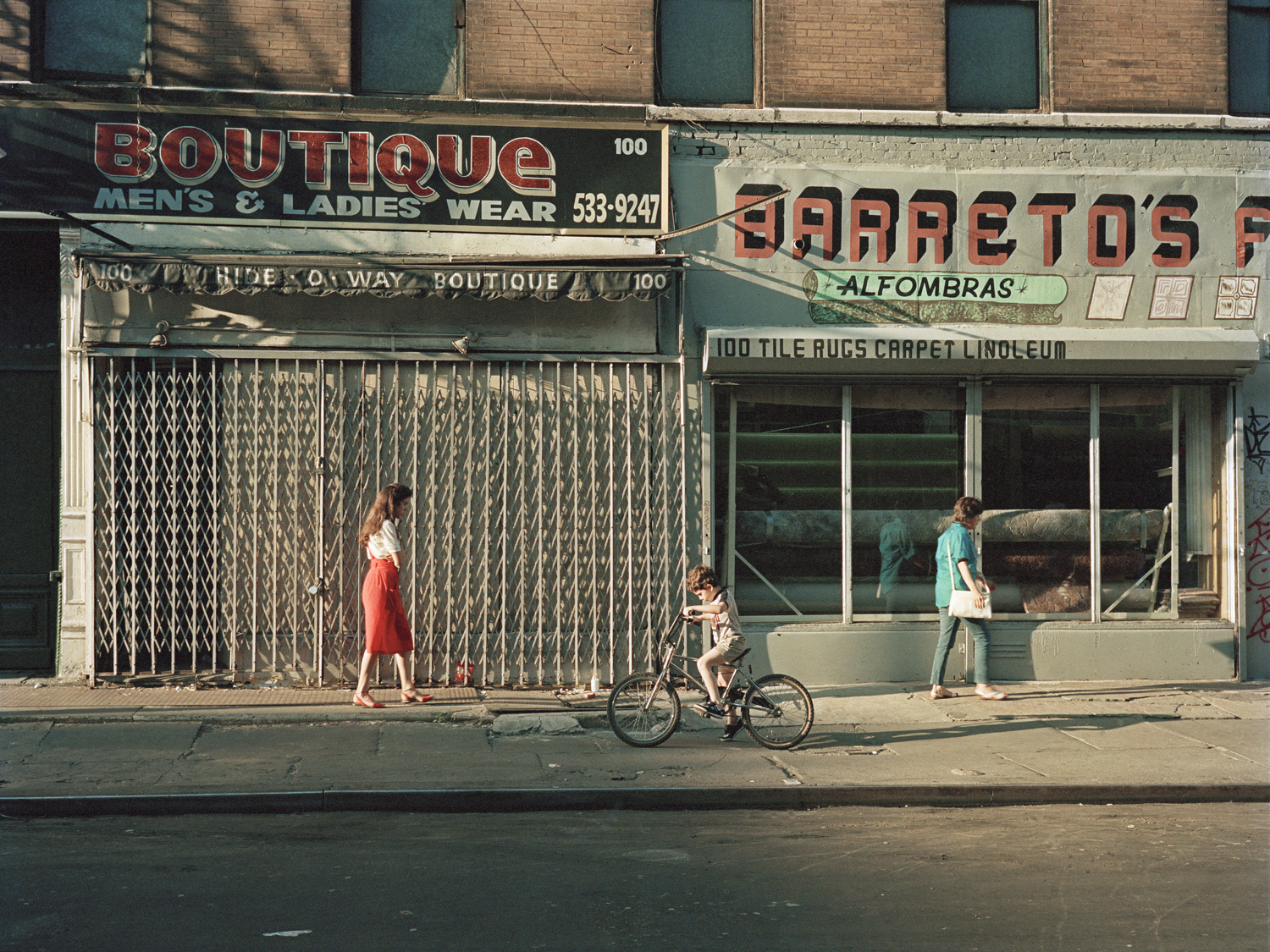Barreto’s on Stanton Street (1987) | 📷: Tria Giovan
On May 28, 1984, New York Magazine announced the death knell of the Lower East Side (LES) with a cover story declaiming the arrival of gentrification. “There Goes the Neighborhood,” the weekly warned, above a photograph of white hipsters in front of a graffiti-covered wall that’s getting buffed. The story chronicled a $1.3-million-dollar real estate deal George Jaffee, a Brooklyn developer specializing in subsidized low-income housing — who had just finessed a 2,000% profit on an apartment building purchased for $62.5K in 1975.
By the late 1970s, an estimated 80% of the neighborhood had been abandoned, burned down, or seized by the government for non-payment of taxes. After more than a decade of “benign neglect” the property, like the neighborhood, remained in a state of dereliction and decay. While white flight kicked into high gear, a new wave of artists, squatters, radicals, and bohemians poured into the LES, including a young photographer named Tria Giovan.

Fresh out of school with a BA in fine art photography, Giovan moved to a tenement building at 29 Clinton Street and immediately fell in love with the neighborhood. A hotbed for counter culture, the LES has developed a style all its own that earned it the title of “the sixth borough.” Located on the literal fringe of southeast Manhattan, the LES became synonymous with the rougher elements of New York life. From the Bowery to Five Points, the LES was a complex mix of poverty, crime, and addiction that drew reformers like Jacob Riis to use photography as a tool of change for his seminal 1890 book, How the Other Half Lives: The Tenements of New York.
The site of some of New York’s earliest tenement buildings, the LES became a landing for new waves of émigrés leaving their homelands behind in the hopes of a better life. Over time, the neighborhood became a patchwork of ethnic enclaves living in close proximity by virtue of the narrow confines of low-income housing. Here Germans, Jews, Italians, Irish, Eastern Europe, Chinese, Puerto Rican, and Dominicans forged little villages on city blocks, becoming the physical manifestation of the mythic image of America’s “melting pot.”

Curious to get to know the neighborhood, Giovan hit the streets with camera in hand, chronicling the majestic theater of daily life amid the kaleidoscopic backdrop of the LES. “It was an energetic city, and you’re trying to make your mark — but it wasn’t all driven by money,” Giovan says. “I felt like I had a lot of freedom because you can be anybody you want in New York and nobody cares. You get on a subway and it’s the most democratic place in the world. Everybody is equal on the subway; you’re all sitting in the same car. I loved being around all these different kinds of people.”
With the May 16 publication of Tria Giovan: Loisaida New York Street Work 1984–1990 (Damiani), she crafts a patchwork tapestry of the majestic and mundane moments, creating a slice of life that perfectly preserves the spirit of old New York. The book’s title, Loisaida, is a nod to the Spanish pronunciation of “Lower East Side,” coined by Puerto Rican writer Bimbo Rivas in a 1974 poem. Written in English and Spanish, Rivas’s words speak to the unbreakable bond. “The mountains and the valleys cannot compare, my love to you Loisaida, I love you,” Rivas wrote. “I dig the way you talk, I dig the way you look. I vibe with your song and I risk it all cold so you live forever.” The poem opens Loisaida, setting the stage for the world that unfolds from page to page, block to block. Giovan moves quietly, taking it all in, and embracing the simple pleasures of city living and bringing us along for the ride.

Nestled within these mundane scenes is the magic of New York: the small town feeling of big city life. Wandering through the streets of the LES, Giovan describes a feeling of joy and wonder as she traveled between the ethnic enclaves, taking in he energy of the streets, and capturing fleeting scenes of street life that has takes on the patina of an urban pastoral with the passage of time. Here: A busboy sweeps down the sidewalk outside El Castillo de Jagua on Rivington Street in the crisp early light of morning. There: a father and two daughters enjoy lunch al fresco, setting up a folding table and couple of chairs on Norfolk Street while their dog quietly dozes at their feet. It’s a throwback to a golden age of New York life that has largely disappeared on the downtown streets.

“It was so interesting to just wander south into Delancey, and you’d end up in this old Jewish neighborhood and go over to the bialy store on East Broadway. It was a different world,” Giovan says. “I wanted to move as silently as possible and not alter the situation at all. It was about discovery of the neighborhood and responding to the world.”
Tria Giovan: Loisaida New York Street Work 1984–1990 (Damiani) launches May 17, 2023, at Rizzoli Bookstore in New York.

You can follow Miss Rosen on Twitter and Instagram.



